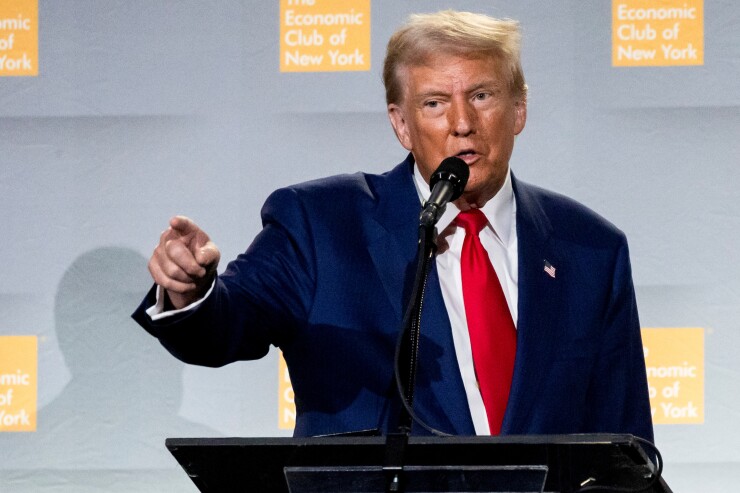Speaking Thursday to the Economic Club of New York, former President Donald Trump proposed the creation of a U.S. sovereign wealth fund to pay for infrastructure projects.
“We’ll create America’s own sovereign wealth fund to invest in great national endeavors for the benefit of all of the American people,” Trump said. “Why don’t we have a wealth fund? Other countries have a wealth funds. We have nothing. We have nothing. We’re going to have a sovereign wealth fund, or we can name it something different.”
Trump did not provide specifics on the proposal and added that the name ‘sovereign wealth fund’ may not be “appropriate.” But the idea would be to create a fund, supported with tariffs on certain goods and other revenues, that would be managed by private managers and make strategic investments in U.S. infrastructure.
Bloomberg
“We will build extraordinary national development projects and everything from highways to airports and to transportation, infrastructure, all of the future. We’ll be able to invest in state-of-the-art manufacturing hubs, advanced defense capabilities, cutting-edge medical research, and help save billions of dollars in preventing disease in the first place.”
The idea marks the latest proposal for a national fund or bank that would be used to finance U.S. infrastructure. Supporters of a national infrastructure bank two weeks ago
Several states, including Alaska, Texas and Montana, have successful sovereign wealth funds and many other countries have national funds, but the U.S. has never had one. For international funds, infrastructure has become an increasingly popular investment over the last several years, according to the International Forum of Sovereign Wealth Funds.
“In 2018, [funds’] direct investments in infrastructure accounted for $6 billion, representing 13% of the annual total. However, by 2022, this figure had risen to over $17 billion, or 25% of total investments,” the IFSWF said in its
But most of those investments are in existing, cash-generating assets, and not new projects, said Michael Likosky, partner at strategic advisory firm Results who has worked for years on national, state and international infrastructure banks. “Sovereign funds are not used generally to fund for what Trump’s talking about,” he said.
Trump’s sovereign wealth fund proposal, like many of the national infrastructure bank proposals, fail to address the main problem with building big national projects in the U.S., Likosky said.
“Money is not the problem,” Likosky said, noting that the country is
“What’s preventing our big projects? It’s that nobody can handle the political issues of crossing jurisdictions. There’s been decades of underinvestment in the country, and the problem is for large projects we handcuff one another,” he said. “If people think a Wall Street banker is going to get people on board, best of luck to them.”
The taxable and direct-pay municipal bond market would prove a more efficient mechanism than the national models, Likosky said, noting that muni market is often adept at ironing out local and regional obstacles.
“If the taxable bond market could get more into these difficult policy questions at a larger scale or with direct pay, just to get the market going, then that’s a much more preferable option.”
